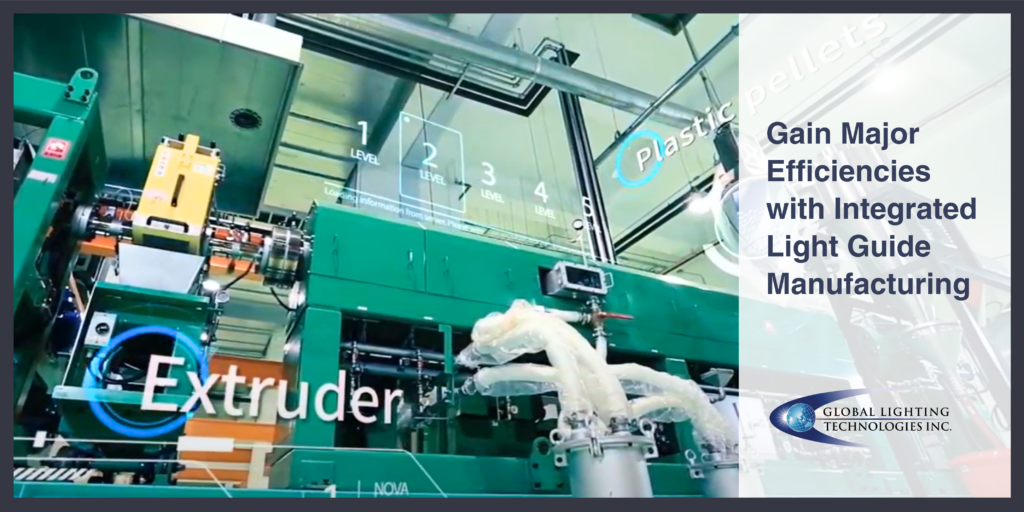
Design and Production Processes Built to Deliver
Integrated light guide manufacturing can transform sourcing challenges into streamlined solutions. I’ve seen firsthand how sourcing multiple components for one part can hamper OEMs’ timelines. Similarly, rigid manufacturing processes that don’t offer creative solutions can lead to inefficiencies. Read on to see how today’s modern advancements achieve material, process, and cost efficiencies.
1. Material Efficiencies—Delivering Fully Finished Products
Sourcing multiple components from different vendors often creates inefficiencies, which can increase costs and production timelines. We streamline this process by using injection molding, which integrates multiple steps into a single manufacturing approach.
Injection Molding: Precision and Efficiency in One Step
This well-established production method produces consistent, high-quality components; we’ve leveraged it for decades and continue to layer on advancements as they’re developed. To take this method even further, we directly incorporate optical patterns into the molding tool which eliminates the need for secondary processing. This ensures that light guides maintain precise optical performance while reducing production steps. Injection molding is most commonly used in consumer electronic, medical, and automotive applications.
In my experience, injection molding allows for more complex designs, plus we can create them faster this way than using other methods. Better still, with dual-shot molding, we can inject two materials simultaneously for enhanced functionality. This technique has proven effective in applications that require added materials without increasing assembly complexity.
We dive deep into injection molding and the capabilities at our Suzhou facility here.
2. Process Efficiencies—Customized Light Guide Manufacturing Production Run Steps
When manufacturers limit OEMs to a single production method, they restrict design choices and efficiency gains. We offer multiple production processes tailored to project requirements, ensuring customers receive optimized solutions without compromise. Our customers often tell me this is one of the major ways we’re set apart from other light guide manufacturers.
Customers Have Options
Each light guide project has unique needs, from material type and thickness to production volume and geometric complexity. The teams I work with create custom light guide designs to accommodate these. In addition to injection molding, we leverage these two production methods to execute on designs.
- Extrusion Embossing: This method ensures consistent optical performance across large-scale designs and is used for high-volume production in consumer electronic applications like televisions. It’s particularly effective in industries requiring precise, repeatable results. Explore more about extrusion embossing and its impact on manufacturing in detail here.
- Thin-Film Embossing: This process produces lightweight, high-performance light guides with custom optical patterns. It’s ideal for consumer electronic applications where space and weight are critical factors, such as keyboard backlights and e-reader frontlights. We cover thin film embossing and its benefits here.
These are purpose-built processes to produce extremely thin optical films. We achieve light guides with the same optical pattern application from our injection molding processes in a high-volume process. This is an invaluable tool for customers who require this kind of process! Our lines also allow us to die-cut light guides to size.
3. Cost Efficiencies—Volume and Inventory Strategies
Cost control is a priority for every manufacturer I talk to, but it’s especially critical in industries that require high-performance light guides. I’ve seen how our production and inventory strategies help customers manage costs without sacrificing quality or reliability.
Scalable Light Guide Manufacturing Volume Options
Production volume plays a key role in cost efficiency. When OEMs are locked into hundreds of thousands of units on a production run, budgets can quickly be drained. We believe OEMs should pay for what they need and not extra. That’s why our production runs range from the low thousands up to extremely high volumes.
Whether it’s prototyping or high-volume manufacturing, our processes are designed to maintain quality across different production scales so customers receive consistent results regardless of order size.
For particularly high-demand products, injection molding and extrusion can easily meet volume requirements. In rare cases where additional tools are needed, we work with customers upfront to establish expectations and ensure production meets demand efficiently.
Some of the largest players in the consumer electronics and automotive industries benefit from our scalable production and inventory management support. Rigorous and demanding industries like those require quick turnarounds and long-term support. It’s no surprise that major brands in both industries rely on our processes and team expertise!
Optimized Inventory Solutions
Effective inventory management can reduce both costs and supply chain risks. Some customers require just-in-time manufacturing, while others prefer stocking programs to secure a steady supply of components. We work directly with customers to develop inventory strategies that align with their production schedules and business needs.
For instance, I’ve worked on internal teams to help customers maintain a buffer stock of critical materials, allowing faster turnaround times when demand spikes. Other light guide manufacturers rely on build-to-order models to minimize excess inventory. Because we can tailor our approach to each project, we help customers navigate supply chain challenges while controlling costs.
Gain Light Guide Manufacturing Capabilities Built to Deliver
Light guide manufacturing shouldn’t be a bottleneck in product development. Work with a light guide manufacturer that integrates multiple production steps, offers tailored manufacturing methods, and optimizes inventory strategies. Together, we can improve your manufacturing efficiency, reduce costs, and streamline your operations.
Reach out to my team and let’s discuss how our expertise can support your next project.